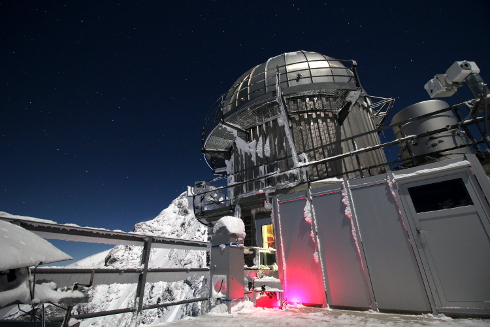New sensor to warn of volcanic ash
Researchers are developing a sensor that detects volcanic ash. The aim is to increase safety in aviation. The challenge: volcanic ash clouds can hardly be distinguished from rain clouds. The sensor could one day also be used as a fire detector.


When Zsófia Jurányi visits the Jungfraujoch, she doesn't hope for steel-blue skies and sunshine. Instead of a breathtaking panorama, she wants clouds - preferably polluted with volcanic ash. Because the researcher at the Institute for Aerosol and Sensor Technology of the University of Applied Sciences Northwestern Switzerland (FHNW) is testing a novel sensor for the detection of volcanic ash particles on behalf of the Federal Office of Civil Aviation (Bazl). "Dual Wavelength volcanic Ash Sensor" or Duwas is the name of the device and it is intended to increase safety in air traffic (Technical Paper on the Duwas measuring principle).
How can volcanic ash be detected?
Six years ago, the eruption of the Icelandic volcano Eyjafjallajökull forced air traffic in northwestern Europe to come to a standstill. Volcanic ash can damage aircraft engines and important sensor systems. The difficulty: an ash cloud is hard to distinguish from a normal rain cloud, especially when the two types of clouds have mixed. Conventional sensors are also unable to distinguish ash particles from water droplets or ice crystals. Both are between one and 20 micrometers in size and scatter visible light equally. The FHNW research team, led by Ernest Weingartner, therefore relies not only on a conventional sensor but also on an infrared sensor that was specially developed for this research project by the Fraunhofer Institute for Applied Solid State Physics. Why an infrared laser? Water and volcanic ash have different refractive indices in the infrared range. At a wavelength of 660 nanometers, ash particles and cloud droplets still look the same. At a wavelength of around 2700 nanometers - i.e. in the infrared range - the desired distinction is made.
Revealing tests on the Jungfraujoch
Zsófia Jurányi is testing the findings from the laboratory at a location that is covered by clouds 40 percent of the time during a year: the Jungfraujoch. She installs the Duwas in the research station at over 3,500 meters above sea level, where it has to prove itself in sub-zero temperatures and gale-force winds. Because a volcanic eruption is rare and unpredictable, the researcher simulates the ash cloud without further ado using "her own" volcanic ash particles collected in Iceland and Sicily. In fact, they succeed in separating the ash from the cloud droplets. A success for the research team.
Sensor also suitable as fire detector
In the future, the Duwas will be used in commercial flights, according to the hopes of the Federal Office of Civil Aviation, which is funding the project. But the sensor could also potentially be used for other purposes where distinguishing between two aerosol particles is important: for example, as a fire detector or as a detector for other specific substances. Initially, the Duwas will now be installed in a small aircraft and tested. The test flights are scheduled to take place this spring. Even then, Zsófia Jurányi will hope for bad weather with lots of clouds.
Sandro Nydegger, University of Applied Sciences FHNW









